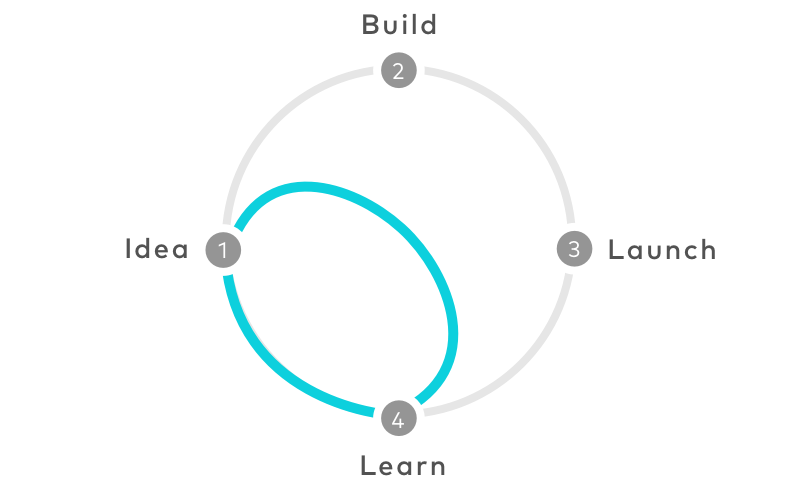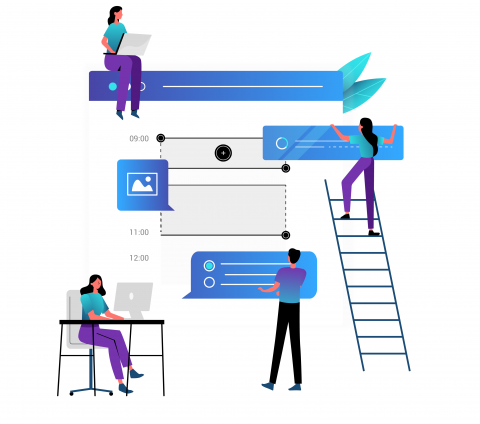Table of contents
1. From digital marketing manager to entrepreneur
1.1 Start-up-as-a-service for corporations
1.2 Part of the customer’s innovation team
1.3 No innovation without user testss
2. Faster implementation of own innovations with Google Design Sprints
2.1 Small teams with a clear focus
2.2 Quicker answers than traditional methods
2.3 Qualitative tests with quantitative validation
3. Reliable recruitment of test users
3.1 Suitable offer for tests during design sprints
3.2 Advantages of external recruitment of test users
4. Get regular feedback and be honest
1. From digital marketing manager to entrepreneur
Susanne Flug, CEO and co-founder of TAKKT, originally comes from the world of marketing and worked in the music industry for many years. In the consulting and agency environment, she supported various companies in the field of innovation management in developing new business models and digital products. This is how she came to meet her co-founder, on one of these projects, and after several projects together, she decided to found her own company with him. Susanne and her colleague took the chance to use their joint skills to expand their offering, to grow, and to gradually consolidate the customer base. Today, they manage their entire business through TAKKT.
1.1 Start-up-as-a-service for corporations
TAKKT has a wide range of customers. All sectors are represented, from the automotive industry to insurance providers and energy companies to media companies. TAKKT is often classified as a consulting company by new customers before starting a joint project. But there is more to TAKKT than just pure consultancy and creating documentation for problems and its solutions. On the contrary, TAKKTpitches in. All of TAKKT’s employees come from the start-up sector. When it comes to customer assignments, they bring precisely this start-up mentality into the company and also act like a start-up there. This is exactly what distinguishes them from classic consulting. They help implement the projects, or implement them all by themselves, and don’t just leave it all to the customer to do that.
1.2 Part of the customer’s innovation team
At TAKKT, the collaboration with customers is much more interactive than in classic consulting. They are part of the team right from the start, frequently including teams within larger corporations. These teams often have an idea and then get stuck in the implementation because they don’t have the necessary resources. Sometimes they just have a problem though, for which TAKKT supports them in finding a solution. This means that TAKKT provides all required roles. And that is what distinguishes them from consultants. They offer everything from a single source. The TAKKT developers build the prototypes, the analysts test them directly on the customer, and the product specialists let them flow back into the iterative stages of development. This is repeated until the prototype has MVP status and until the first version of the product is made. TAKKT then slowly steps back from the project.
1.3 No innovation without user tests
User testing plays a key role at TAKKT. Many of its customers have neglected the tests far too often in the past when developing digital products. Or they didn’t perform any tests at all. Often, it was, or is, difficult for them to speak to just one potential user, let alone even find one in the first place. Large companies, in particular, are sometimes bound by regulations that prohibit them from discussing a raw idea with external people before it has been approved by various authorities. Furthermore, they sometimes lack experience in the area of idea validation.
However, TAKKT makes sure that potential users are spoken to for every project. No idea is implemented without first speaking to the potential users. Validation is one of the three pillars at TAKKT that are strictly adhered to. And it is a central pillar for the success of the product. Suitable test users are recruited at TestingTime. TAKKT tests the ideas for a large number of different projects and customers with test users from the appropriate target group on an ongoing basis, often even weekly.

TAKKT’s three pillars: ideation, subsequent validation and the prototyping phase.
2. Faster implementation of own innovations with Google Design Sprints
In addition to the innovations that TAKKTdrives for customers, they also develop their own solutions. They get the inspiration for these from their own everyday work, or their customers’ work, and their customers’ problems. TAKKT proceeds in exactly the same way with their own developments as they do with their customer projects. They regularly discuss various problems and possible solutions to these in very small teams. Similarly to when at a customer, they develop the first prototypes after a brainstorming session. And they implement these very early on, very quickly, and in very short cycles.
If the idea or prototype is not convincing, they quickly discard it. They are able to do this without a guilty conscience, because it does not involve a lot of effort or high costs. Right in line with the Google Design Sprint ideology. They have been pressing further ahead with one of their current ideas, or a current product, according to this principle since this summer.
However, they have adapted the development process a little for their own purposes by shortening certain processes after the initial learnings and lengthening others somewhat in return. TAKKT roughly adheres to the structure provided by Google, but has made a few individual adjustments within this structure. For example, they use some tools that Google suggests, but some they don’t, because the effort would be far too great. And they try to act as much as possible like a start-up in this area as well.
2.1 Small teams with a clear focus
TAKKT works in a mixed team for all of its projects. It is always deliberately a small team. According to Google’s guidelines, anything above 8 people is ineffective. Only four people are working on the current product: one business person (or product manager), one designer, and two developers. All four people are also involved in the user tests, so that everyone has the same level of knowledge and no important findings are lost. Every person involved finds out 1:1 what the potential customer thinks of the product.
2.2 Quicker answers than with traditional methods
For TAKKT, the Google Design Sprints are exactly the right method because of their speed. Many of its customers also believe in this, and use this method with TAKKT’s assistance. Of course, TAKKT also adapts its innovation methods to the customer sometimes. However, the pressure to develop something very quickly and in a focused manner brings certain advantages. For one thing, you only do what is necessary. When you have more time, you often do too much. In principle, you can validate hypotheses about the idea you have at the end of every week. If something doesn’t work, for whatever reason, or is not accepted by users, you can quickly discard it. And you can do so systematically. This way, you avoid falling too much in love with your own idea and holding onto a solution that interests nobody for too long.
TAKKT has been carrying out these weekly tests for the development of its current product for over two months. In other words, they have a prototype every week, which they either develop further or build again completely from scratch after testing it with five potential users every Friday.

The sprint offers teams a shortcut to learning without building and launching (source: Google Ventures – The Design Sprint).
2.3 Qualitative tests with quantitative validation
TAKKT plans the various tests with the potential users every month. So far, they have mainly consisted of face-to-face interviews on site, which are also the preferred option according to the Google Design Sprint rules. Of course, the interviews only take place in compliance with the relevant guidelines and safety measures. Due to the coronavirus, a mixture of on-site and remote interviews are now being conducted. In the meantime, Google has also adapted its guidelines to be in line with the remote design sprints. Qualitative interviews are carried out monthly with 20 people in total. The findings are then validated using a quantitative survey involving 100 people.
3. Reliable recruitment of test users
Before TAKKT came to TestingTime, they recruited their test users through a variety of channels. Most of the time, however, they used social media for the recruiting. They put up posts in various social media groups and looked for suitable candidates. Or they used the channels of universities through student employees. Still, all of these options were neither reliable nor time-saving. TAKKT was thus soon on the lookout for an external recruiter, and came across TestingTime through a recommendation.
3.1 Suitable offer for tests during design sprints
After the TAKKT team and Susanne had taken a closer look at TestingTime and tested the service, they soon asked for a suitable offer for their design sprints. Due to the high test volume for their current in-house project, TestingTime made a special offer for this construct. Susanne appreciated the fact that she was able to speak to us in an uncomplicated manner and that we were utterly flexible in putting together the right package for her. This solution already proved to be the right one within the first design sprints, and had a positive impact on the project. Thanks to reliable recruitment, they can test more ideas and solve significantly more problems than before in the same amount of time. This has not only saved them time, but also money.
3.2 Advantages of external recruitment of test users
Susanne appreciated the fact that she was able to speak to TestingTime personally in order to clarify the desired profile criteria and the overall context of the tests. Afterwards, she was glad that she was able to hand over the entire recruiting effort to TestingTime—from screening the candidates to recruitment and scheduling to incentivising the test users.
Thanks to TestingTime, TAKKT is able to recruit perfect-fit test users from an international and representative pool for both its own projects and customer projects. When recruiting for customer projects, the desired profiles vary from project to project. It is not always just end customers who are sought for tests, but also business customers, such as decision makers in SMEs or other B2B profiles.
4. Get regular feedback and be honest
Susanne’s biggest learning and biggest tip is to talk openly about ideas and test them as quickly as possible. And not to be guided by the fear that the idea could be stolen during validation. In order to be able to develop a product or service and, above all, to ensure its success, it is essential to collect feedback regularly, regardless of the form in which the feedback is obtained. If possible, you should also do this with people you don’t know, who are unbiased and completely honest. If you test with friends or employees, the results can quickly be biased. Plus, it’s perfectly okay to admit that an idea doesn’t work and doesn’t solve a problem. It is okay to then resolutely not pursue that idea any longer. For Susanne, it, therefore, makes the most sense to think in short cycles. And to test as much as possible.
If you want to know which product TAKKT is currently working on, you can find out more about Takkt here. A brief insight: they are building a tool you can use to prepare meetings better, conduct them more effectively, and better track decisions. It is also suitable for recording test results. You can find more information about TAKKT here.

Takkt Minutes: meeting productivity. Redefined.
